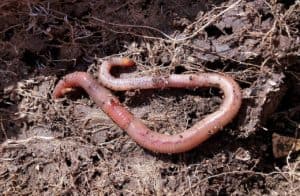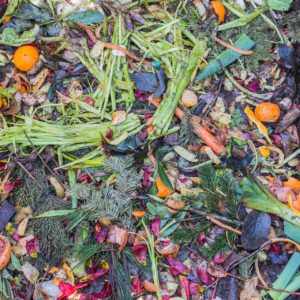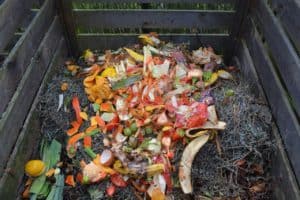
Guest Blogger | A Full Circle: The Conclusion from Growth to Ground
Part of my Fl!p Your K!tchen™ system encourages you to minimize the amount of food wasted in your household. There are plenty of ways to “flip” your ingredients, but if they’ve really passed the point of no return (points to you if you got the Andrew Lloyd Weber reference), don’t throw them out! Whether you live in an apartment or have a spacious lot, I encourage you to learn to compost. Today’s guest blogger is my sister friend and book editor, Marine Yanikian Sutton, an educator in Los Angeles who brought composting into my life almost 10 years ago. Thanks to her, my basement houses a “composting condo” full of red wrigglers. I call them “the quietest, most low-maintenance pets ever.” And added bonus: my son occasionally raids the compost for fishing bait…. You can really go down a rabbit hole (worm hole?) researching how to compost properly, but I recommend Marine’s approach: try it!
 First, be assured that I am not a gardener. This isn’t what I do for a living. I am not an avid entomologist and don’t necessarily love insects; on the contrary, I am an educator who forces people to push their boundaries and grapple with insecurities. But I learned how to compost five years ago, and if I can do it, then so can you. [Liza: Um—you killed your first barrel while we were still in LA…10 years ago? I still remember how distraught you were.]
First, be assured that I am not a gardener. This isn’t what I do for a living. I am not an avid entomologist and don’t necessarily love insects; on the contrary, I am an educator who forces people to push their boundaries and grapple with insecurities. But I learned how to compost five years ago, and if I can do it, then so can you. [Liza: Um—you killed your first barrel while we were still in LA…10 years ago? I still remember how distraught you were.]
As all food comes from the ground, it must likewise return to the ground. Thus, we end with this intense rationalized ideal: all fruits and vegetables would be consumed, and nothing would go to waste. However, wasted food or “goober,” as it is so heinously called in my household, does occur. Fortunately, my youngest son has taken on a passionate stance where this is concerned: all fruits, vegetables, and even eggshells are stored in an airtight container under the sink. Daily, he takes them outside and adds them to our compost pile.
How do you know if it is compostable? If it once grew, if it is a producer, if it is leafy, green, fruity, or a vegetable, then it can be returned to the compost pile. Dairy, cheese, and meat are exceptions. The last time I tried to bury a fish in the garden, a bear dug it up. I would refrain from burying meat altogether. Coffee grounds and egg-shells are in their own category and they do end up in the pile. [Liza: I wonder whether you have better luck with fruit because it’s outside? The moment I add fruit, I have fruit flies. Ditto for grains.]
 We’ve tried this many times in different ways. Numerous times, we’ve accidentally killed all of the worms, once while harvesting them on a hot day, and another time, a winter storm drowned them. We’re not proud of our failures, but we sure did learn from them. We’ve built compost bins with plastic containers from the hardware store, we’ve purchased a large hand cranked rotating compost barrel online, and we’ve constructed our own out of a flowerbed. In the end, regardless of the method selected, the end result is the same. You need to create a habitat where earthworms have moisture, soil, green and brown clippings, as well as your fruits/veggies. There is no one right way to do it, so experimenting is the best way.
We’ve tried this many times in different ways. Numerous times, we’ve accidentally killed all of the worms, once while harvesting them on a hot day, and another time, a winter storm drowned them. We’re not proud of our failures, but we sure did learn from them. We’ve built compost bins with plastic containers from the hardware store, we’ve purchased a large hand cranked rotating compost barrel online, and we’ve constructed our own out of a flowerbed. In the end, regardless of the method selected, the end result is the same. You need to create a habitat where earthworms have moisture, soil, green and brown clippings, as well as your fruits/veggies. There is no one right way to do it, so experimenting is the best way.
Since worms multiply faster than rabbits, you don’t need to start with a lot. A handful is more than enough. You can buy them from your local nursery, but the last time we tried to do that they wanted to charge us $20 for a small container. Although so-called “composting worms” are different from nightcrawlers, we’ve had good luck with them. You can try to dig some up after a rainstorm, or you can visit your local tackle shop, where you can buy a small container of earthworms for half the price the nursery would have charged. [Liza: I got my red wrigglers from https://unclejimswormfarm.com/—they actually show up on your doorstep in a bag, and I recommend ordering them on a day you know they won’t cook in the sun while you’re at work….]
 Although my little one calls them his “pets,” we did manage to deter him from naming any of them. On this last go around, we decided to use a planter bed to start our compost. We layered dirt/leaves/ fruit and veggie trimmings/worms/dirt/more lawn clippings. We sprinkled the pile with water, not enough to drown the worms, but enough to keep their home moist,
Although my little one calls them his “pets,” we did manage to deter him from naming any of them. On this last go around, we decided to use a planter bed to start our compost. We layered dirt/leaves/ fruit and veggie trimmings/worms/dirt/more lawn clippings. We sprinkled the pile with water, not enough to drown the worms, but enough to keep their home moist,
like a wet sponge. We then covered the top with wood so that our dog wouldn’t dig it all up, leaving some space for air to circulate. Weekly, we’ll add more food and turn the soil a bit, just to give our pets a bit of air and space to work their magic. When it’s time to harvest, we’ll start a new pile a short distance from this first one and as the food runs out in the first pile, our “pets” will migrate to the second to begin their feast, allowing us to harvest the compost and add it to our garden.
And that is how the circle of life goes round and round: what comes from healthy soil is the healthiest substance you can consume, and what you give back to the soil will only add to the wholeness of the food produced. So if you are feeling adventurous, do a bit more research and then dive in with your own composting plan. Before you know it, it will all become second nature.
All photos above from pixabay.com
 Marine Yanikian-Sutton was born in Yerevan, Armenia, and immigrated to the US with her parents, at the age of 1. Raised in Southern CA, she attended USC, where she studied English Literature and Education. She has followed her calling to educate and change lives since 1999. She is a teacher, mother, grant-writer, and advocate for the underserved. Gardening is one way she re-centers herself and gives back to the earth. This picture was taken in 2012, when Marine and her husband (center) took their two boys on a cross-country adventure and came to visit!
Marine Yanikian-Sutton was born in Yerevan, Armenia, and immigrated to the US with her parents, at the age of 1. Raised in Southern CA, she attended USC, where she studied English Literature and Education. She has followed her calling to educate and change lives since 1999. She is a teacher, mother, grant-writer, and advocate for the underserved. Gardening is one way she re-centers herself and gives back to the earth. This picture was taken in 2012, when Marine and her husband (center) took their two boys on a cross-country adventure and came to visit!



